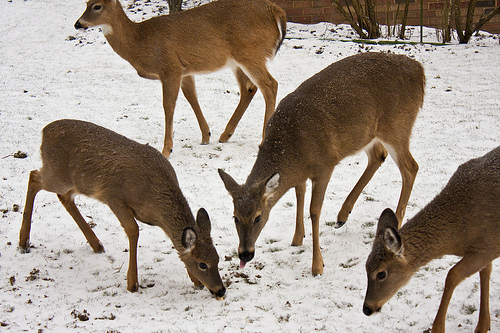Why deer can be attracted to gas drilling sites
-
Marie Cusick

JohnWDavisJr via Flickr
Deer are attracted to salty spots, which can include areas exposed to flowback fluid from gas development.
Hunters have long known deer love salt. In Pennsylvania it’s illegal to put out salt licks to try to attract deer. But there are still salty spots deer find on their own.
One of those places can be gas drilling sites.The brine water that comes back up after hydraulic fracturing (known as flowback) can be as much as 10 times saltier than seawater. It can also contain heavy metals and radioactive materials.
The state Department of Environmental Protection acknowledges that brine spills large and small do occur, and they have not studied its impacts to wildlife.
Pennsylvania Game Commission spokesman Travis Lau says they haven’t studied gas drilling’s impact on deer either, but anecdotally, brine is not much of an issue.
“Not to say it’s not happening,” he says. “But our guys that work pretty closely with the gas industry haven’t really seen that.”
U.S. Forest Service soil scientist, Mary Beth Adams, has studied deer’s attraction to the salt left behind in the soil at reclaimed drilling sites in West Virginia, which has less stringent regulations related to flowback. She recently spoke with StateImpact Pennsylvania about her research.
Note: this interview has been edited for length and clarity
Q: What do we know in terms of how this affects the food system?
A: There’s relatively little research in general on the effects of natural gas development. I’m not familiar with much research on the effects of wildlife or even on vegetation. It simply hasn’t been done. The pace of development is outpacing the research.
Q: What kind of work do you do?
A: The Forest Service manages land. I’m part of the research division. I do research to help people understand how ecosystems work, how they behave when they’re stressed, and how to manage them better for a variety of uses.
The research I described here was based on our experience on the Fernow Experimental Forest, which is a research forest. A conventional gas well was developed on the Fernow, and we looked at the impacts after the development of the gas well.
Q: What did you find? There was a lot of dead vegetation, right? Was flowback sprayed on it?
A: Right. In West Virginia it is permissible to apply flowback fluids to the land as long as they meet state regulations. [Note: this is illegal in Pennsylvania] You actually get a permit to do that. But the permit standard is a concentration standard, not a dose standard.
So for example, you can get a brief whiff of hydrogen sulfide and that’s not going to be toxic to you as a human being. But if you are exposed to a huge amount of it, even if the concentration’s the same, it’s more dangerous. It’s like medicine.
What we found was the concentration standard did not protect the forest vegetation. What happened was too much [flowback fluid] was applied on too small an area. And it was mostly the salts –calcium and sodium chloride– that negatively affected the vegetation. It was affected first through immediate contact, but then by uptake and also the physiological function of the trees.
Q: Can you describe what you found with deer populations near gas development?
A: Deer have a requirement as they come out in spring in early summer; they need more minerals. The deer are attracted to natural minerals sources, like salt.
In this case, where the flowback pond had been there were salts near the surface and they were leaching out in a small spring. So the deer were attracted to it. It brings the deer in from a great distance around, and it concentrates them.
Q: So if they’re eating salt, that doesn’t sound too concerning. Could there be an issue with the quality of the venison?
A: It depends on what else is in there. The salts themselves — sodium and calcium chloride– are part of the salt blocks people put out to attract deer. We all eat sodium chloride in our meals.
But there are other constituents that are probably associated with those salts. The deer may be ingesting those as well– the heavy metals and the radionuclides. We don’t know. There’s been so little work done on what’s in there. And then how it moves through the ecosystem. Maybe it all leaches out quickly. Probably it doesn’t. But we don’t know that.
Q: So for avid hunters, is this something they should be aware of?
A: It would be really good if the Food and Drug Administration or somebody who does public health research could look at this. It would be relatively easy to do some simple [sampling]. But the states are not going to have the funding to do that, and I’m not aware the federal government is doing that.
Q: Anything else?
A: Just that the gas boom has moved so quickly, [and] the research is way far behind the development of the resource. We do this over and over again. We find something that’s wonderful– usually related to energy– and we just rush ahead without thinking about what the impacts are. We did it with coal, we’ve done it with oil, we’re doing it with gas, we did it with nuclear.
It would be nice if humans were a little less impetuous and that we would actually think about what might be the potential impacts and do some research before we run away with it, but I think it’s probably human nature.
















